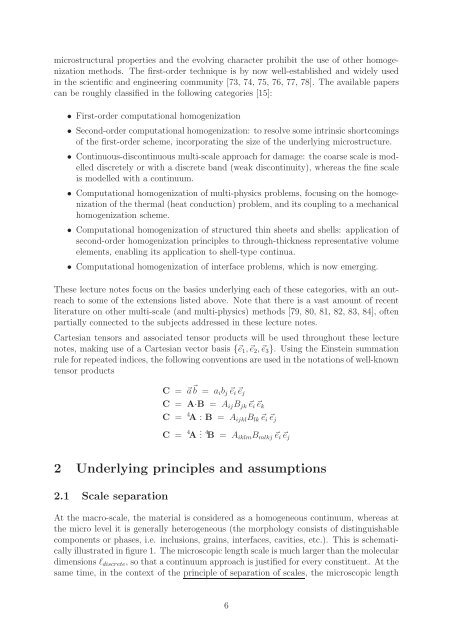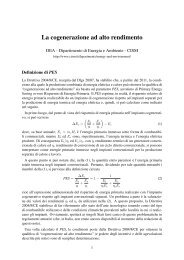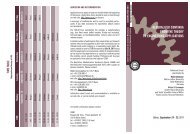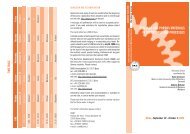Scale transitions in solid mechanics based on computational ... - Cism
Scale transitions in solid mechanics based on computational ... - Cism
Scale transitions in solid mechanics based on computational ... - Cism
- No tags were found...
Create successful ePaper yourself
Turn your PDF publications into a flip-book with our unique Google optimized e-Paper software.
microstructural properties and the evolv<str<strong>on</strong>g>in</str<strong>on</strong>g>g character prohibit the use of other homogenizati<strong>on</strong>methods. The first-order technique is by now well-established and widely used<str<strong>on</strong>g>in</str<strong>on</strong>g> the scientific and eng<str<strong>on</strong>g>in</str<strong>on</strong>g>eer<str<strong>on</strong>g>in</str<strong>on</strong>g>g community [73, 74, 75, 76, 77, 78]. The available paperscan be roughly classified <str<strong>on</strong>g>in</str<strong>on</strong>g> the follow<str<strong>on</strong>g>in</str<strong>on</strong>g>g categories [15]:• First-order computati<strong>on</strong>al homogenizati<strong>on</strong>• Sec<strong>on</strong>d-order computati<strong>on</strong>al homogenizati<strong>on</strong>: to resolve some <str<strong>on</strong>g>in</str<strong>on</strong>g>tr<str<strong>on</strong>g>in</str<strong>on</strong>g>sic shortcom<str<strong>on</strong>g>in</str<strong>on</strong>g>gsof the first-order scheme, <str<strong>on</strong>g>in</str<strong>on</strong>g>corporat<str<strong>on</strong>g>in</str<strong>on</strong>g>g the size of the underly<str<strong>on</strong>g>in</str<strong>on</strong>g>g microstructure.• C<strong>on</strong>t<str<strong>on</strong>g>in</str<strong>on</strong>g>uous-disc<strong>on</strong>t<str<strong>on</strong>g>in</str<strong>on</strong>g>uous multi-scale approach for damage: the coarse scale is modelleddiscretely or with a discrete band (weak disc<strong>on</strong>t<str<strong>on</strong>g>in</str<strong>on</strong>g>uity), whereas the f<str<strong>on</strong>g>in</str<strong>on</strong>g>e scaleis modelled with a c<strong>on</strong>t<str<strong>on</strong>g>in</str<strong>on</strong>g>uum.• Computati<strong>on</strong>al homogenizati<strong>on</strong> of multi-physics problems, focus<str<strong>on</strong>g>in</str<strong>on</strong>g>g <strong>on</strong> the homogenizati<strong>on</strong>of the thermal (heat c<strong>on</strong>ducti<strong>on</strong>) problem, and its coupl<str<strong>on</strong>g>in</str<strong>on</strong>g>g to a mechanicalhomogenizati<strong>on</strong> scheme.• Computati<strong>on</strong>al homogenizati<strong>on</strong> of structured th<str<strong>on</strong>g>in</str<strong>on</strong>g> sheets and shells: applicati<strong>on</strong> ofsec<strong>on</strong>d-order homogenizati<strong>on</strong> pr<str<strong>on</strong>g>in</str<strong>on</strong>g>ciples to through-thickness representative volumeelements, enabl<str<strong>on</strong>g>in</str<strong>on</strong>g>g its applicati<strong>on</strong> to shell-type c<strong>on</strong>t<str<strong>on</strong>g>in</str<strong>on</strong>g>ua.• Computati<strong>on</strong>al homogenizati<strong>on</strong> of <str<strong>on</strong>g>in</str<strong>on</strong>g>terface problems, which is now emerg<str<strong>on</strong>g>in</str<strong>on</strong>g>g.These lecture notes focus <strong>on</strong> the basics underly<str<strong>on</strong>g>in</str<strong>on</strong>g>g each of these categories, with an outreachto some of the extensi<strong>on</strong>s listed above. Note that there is a vast amount of recentliterature <strong>on</strong> other multi-scale (and multi-physics) methods [79, 80, 81, 82, 83, 84], oftenpartially c<strong>on</strong>nected to the subjects addressed <str<strong>on</strong>g>in</str<strong>on</strong>g> these lecture notes.Cartesian tensors and associated tensor products will be used throughout these lecturenotes, mak<str<strong>on</strong>g>in</str<strong>on</strong>g>g use of a Cartesian vector basis {⃗e 1 ,⃗e 2 ,⃗e 3 }. Us<str<strong>on</strong>g>in</str<strong>on</strong>g>g the E<str<strong>on</strong>g>in</str<strong>on</strong>g>ste<str<strong>on</strong>g>in</str<strong>on</strong>g> summati<strong>on</strong>rule for repeated <str<strong>on</strong>g>in</str<strong>on</strong>g>dices, the follow<str<strong>on</strong>g>in</str<strong>on</strong>g>g c<strong>on</strong>venti<strong>on</strong>s are used <str<strong>on</strong>g>in</str<strong>on</strong>g> the notati<strong>on</strong>s of well-knowntensor productsC = ⃗a ⃗ b = a i b j ⃗e i ⃗e jC = A·B = A ij B jk ⃗e i ⃗e kC = 4 A : B = A ijkl B lk ⃗e i ⃗e jC = 4 A . 4 B = A iklm B mlkj ⃗e i ⃗e j2 Underly<str<strong>on</strong>g>in</str<strong>on</strong>g>g pr<str<strong>on</strong>g>in</str<strong>on</strong>g>ciples and assumpti<strong>on</strong>s2.1 <str<strong>on</strong>g>Scale</str<strong>on</strong>g> separati<strong>on</strong>At the macro-scale, the material is c<strong>on</strong>sidered as a homogeneous c<strong>on</strong>t<str<strong>on</strong>g>in</str<strong>on</strong>g>uum, whereas atthe micro level it is generally heterogeneous (the morphology c<strong>on</strong>sists of dist<str<strong>on</strong>g>in</str<strong>on</strong>g>guishablecomp<strong>on</strong>ents or phases, i.e. <str<strong>on</strong>g>in</str<strong>on</strong>g>clusi<strong>on</strong>s, gra<str<strong>on</strong>g>in</str<strong>on</strong>g>s, <str<strong>on</strong>g>in</str<strong>on</strong>g>terfaces, cavities, etc.). This is schematicallyillustrated <str<strong>on</strong>g>in</str<strong>on</strong>g> figure 1. The microscopic length scale is much larger than the moleculardimensi<strong>on</strong>s l discrete , so that a c<strong>on</strong>t<str<strong>on</strong>g>in</str<strong>on</strong>g>uum approach is justified for every c<strong>on</strong>stituent. At thesame time, <str<strong>on</strong>g>in</str<strong>on</strong>g> the c<strong>on</strong>text of the pr<str<strong>on</strong>g>in</str<strong>on</strong>g>ciple of separati<strong>on</strong> of scales, the microscopic length6









